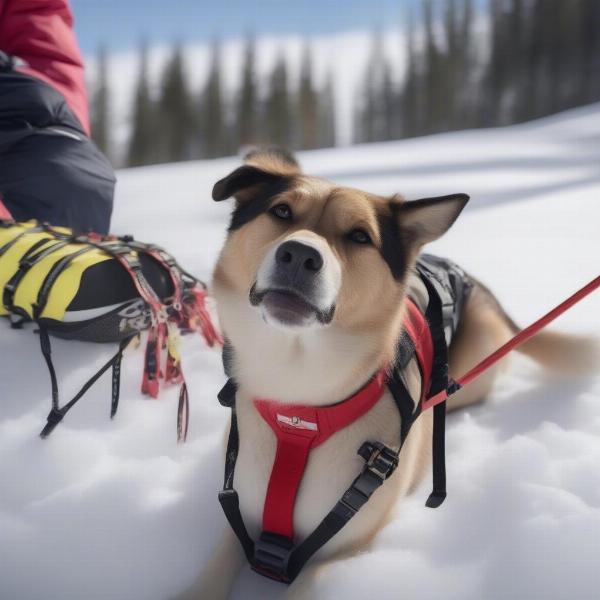Dog skiing, or skijoring, is a fantastic way to enjoy the snowy landscapes with your canine companion. It’s a fun, healthy activity that strengthens your bond and provides both of you with much-needed exercise during the colder months. Whether you’re a seasoned skier or just starting out, this guide will help you understand the basics of dog skiing and ensure a safe and enjoyable experience for both you and your furry friend.
Getting Started with Dog Skiing: Essential Gear and Preparation
Before hitting the trails, it’s crucial to equip yourself and your dog with the right gear. For you, this includes cross-country skis, ski poles, and a skijoring belt. Your dog will need a well-fitting harness designed for pulling, a bungee leash to absorb shock, and booties to protect their paws from ice and snow. Proper preparation is also key. Start with short training sessions on flat terrain to acclimate your dog to the equipment and commands. Gradually increase the distance and difficulty as they become more comfortable.
 Dog Skiing Gear Essentials
Dog Skiing Gear Essentials
Choosing the right location is just as important as the right gear. Look for trails specifically designated for dog skiing or areas with packed snow and minimal obstacles. Remember to check the weather conditions before heading out and avoid skiing in extreme cold or icy conditions.
Training Your Dog for Skijoring: Commands and Techniques
Training your dog for skijoring involves teaching them basic commands like “hike” (to go), “gee” (to turn right), “haw” (to turn left), and “whoa” (to stop). Positive reinforcement, such as praise and treats, is the most effective training method. Start with short, fun sessions, and gradually increase the duration and intensity as your dog progresses.
Consistency and patience are vital. It’s important to remember that every dog learns at a different pace. Be prepared to adjust your training approach based on your dog’s individual needs and temperament. Don’t forget to make it fun! The more your dog enjoys the activity, the quicker they’ll learn. “Building a strong foundation of trust and communication between you and your dog is paramount for a successful and enjoyable skijoring experience,” says renowned dog trainer, Sarah Miller.
Safety Tips for Dog Skiing: Ensuring a Safe and Enjoyable Adventure
Safety should always be your top priority when dog skiing. Ensure your dog is physically fit and healthy enough for this activity. Consult your veterinarian before starting any new exercise program. Always be aware of your surroundings and keep a safe distance from other skiers and wildlife.
Carry plenty of water for both you and your dog, and take breaks when needed. It’s also a good idea to carry a first-aid kit for both human and canine injuries. Remember to respect the environment and pack out any waste. Experienced veterinarian, Dr. Emily Carter, advises, “Regularly check your dog’s paws for signs of injury or discomfort during and after skijoring. Early detection and treatment can prevent more serious problems.”
Conclusion: Embrace the Winter Fun with Dog Skiing
Dog skiing is a rewarding experience that allows you and your furry friend to embrace the beauty of winter. With proper preparation, training, and safety precautions, you can create lasting memories and strengthen your bond with your canine companion. So, gear up, grab your skis, and explore the snowy trails together!
FAQ:
- What breeds are best suited for dog skiing? Breeds with high energy levels and a natural love for the snow, such as Huskies, Malamutes, and Samoyeds, are often well-suited for skijoring. However, any dog with a good temperament and physical fitness can participate with proper training.
- What age can a dog start skijoring? It’s generally recommended to wait until a dog’s growth plates have closed, typically around 12-18 months old, before starting any pulling activities.
- What should I do if my dog gets injured while skijoring? Carry a first-aid kit and know basic canine first aid. If your dog sustains a serious injury, seek veterinary attention immediately.
- Where can I find dog-friendly ski trails? Many ski resorts and parks offer designated dog-friendly trails. Check local regulations and websites for information.
- Is special equipment necessary for dog skiing? Yes, specialized equipment like a pulling harness, bungee leash, and dog booties are essential for safe and comfortable dog skiing.
- How do I teach my dog skijoring commands? Use positive reinforcement techniques, such as praise and treats, to teach commands like “hike,” “gee,” “haw,” and “whoa.”
- What are the safety precautions for dog skiing? Check weather conditions, ensure your dog is fit, carry water and a first-aid kit, and be aware of your surroundings.
ILM Dog is a leading international online resource dedicated to providing expert advice on dog care, breeds, health, training, nutrition, and more. We offer valuable insights and practical tips for dog owners of all experience levels, helping you build a stronger bond with your canine companion. From choosing the right breed to ensuring their well-being, ILM Dog is your go-to source for all things dog-related. Contact us at [email protected] or +44 20-3965-8624 for personalized advice. Visit us at ILM Dog for a wealth of information to enhance your dog’s life.